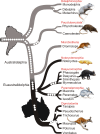Tracking marsupial evolution using archaic genomic retroposon insertions
- PMID: 20668664
- PMCID: PMC2910653
- DOI: 10.1371/journal.pbio.1000436
Tracking marsupial evolution using archaic genomic retroposon insertions
Abstract
The Australasian and South American marsupial mammals, such as kangaroos and opossums, are the closest living relatives to placental mammals, having shared a common ancestor around 130 million years ago. The evolutionary relationships among the seven marsupial orders have, however, so far eluded resolution. In particular, the relationships between the four Australasian and three South American marsupial orders have been intensively debated since the South American order Microbiotheria was taxonomically moved into the group Australidelphia. Australidelphia is significantly supported by both molecular and morphological data and comprises the four Australasian marsupial orders and the South American order Microbiotheria, indicating a complex, ancient, biogeographic history of marsupials. However, the exact phylogenetic position of Microbiotheria within Australidelphia has yet to be resolved using either sequence or morphological data analysis. Here, we provide evidence from newly established and virtually homoplasy-free retroposon insertion markers for the basal relationships among marsupial orders. Fifty-three phylogenetically informative markers were retrieved after in silico and experimental screening of approximately 217,000 retroposon-containing loci from opossum and kangaroo. The four Australasian orders share a single origin with Microbiotheria as their closest sister group, supporting a clear divergence between South American and Australasian marsupials. In addition, the new data place the South American opossums (Didelphimorphia) as the first branch of the marsupial tree. The exhaustive computational and experimental evidence provides important insight into the evolution of retroposable elements in the marsupial genome. Placing the retroposon insertion pattern in a paleobiogeographic context indicates a single marsupial migration from South America to Australia. The now firmly established phylogeny can be used to determine the direction of genomic changes and morphological transitions within marsupials.
Conflict of interest statement
The authors have declared that no competing interests exist.
Figures


Comment in
-
Jumping genes reveal kangaroos' origins.PLoS Biol. 2010 Jul 27;8(7):e1000437. doi: 10.1371/journal.pbio.1000437. PLoS Biol. 2010. PMID: 20668663 Free PMC article. No abstract available.
References
-
- Szalay F. S. A new appraisal of marsupial phylogeny and classification. In: Archer M, editor. Carnivorous marsupials. Sydney: Royal Zoological Society of New South Wales; 1982. pp. 621–640.
-
- Flynn J. J, Wyss A. E. Recent advances in South American mammalian paleontology. Trends Ecol Evol. 1998;13:449–454. - PubMed
-
- Nilsson M, Arnason U, Spencer P. B. S, Janke A. Marsupial relationships and a timeline for marsupial radiation in South Gondwana. Gene. 2004;340:189–196. - PubMed
-
- Meredith R. W, Westerman M, Case J. A, Springer M. S. A phylogeny and timescale for marsupial evolution based on sequences for five nuclear genes. J Mamm Evol. 2008;15:1–26.
-
- Mikkelsen T. S, Wakefield M. J, Aken B, Amemiya C. T, Chang J. L, Duke S, et al. Genome of the marsupial Monodelphis domestica reveals innovation in non-coding sequences. Nature. 2007;447:167–177. - PubMed
Publication types
MeSH terms
Substances
LinkOut - more resources
Full Text Sources

